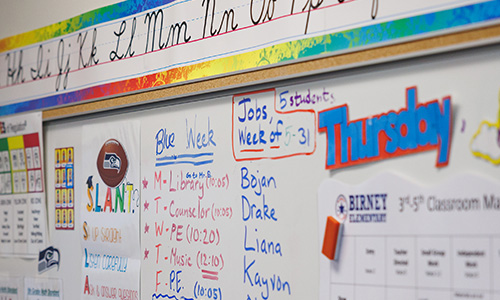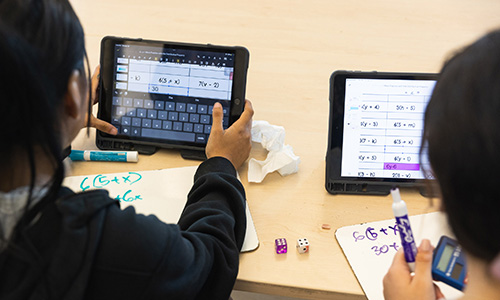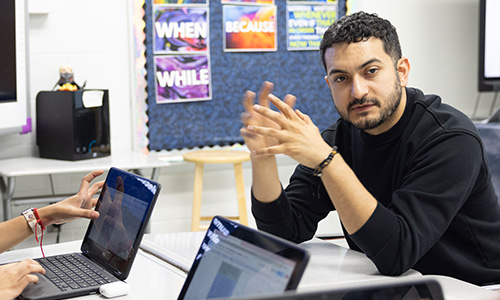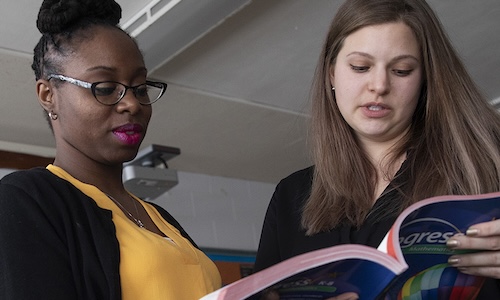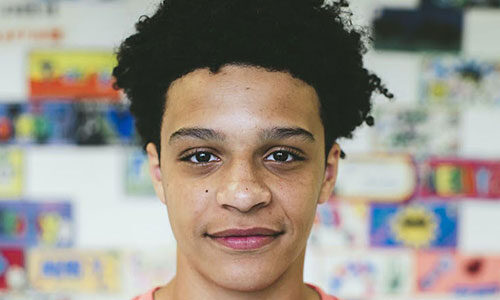 A few years ago, I was chatting with a friend who is an amazing artist. She excitedly told me how she was learning to code and how much she was enjoying it because it was so creative. Creative? Really? While listening to her, I could almost hear the sound of a needle tearing across a record. I had always assumed it was technical, dry, and, frankly, the antithesis of creative. Talking to her more, I learned that coding is essentially problem-solving. Coders need to figure out how to get from the current state to the desired state using a particular coding language. How you get there is open for you to explore with many possible approaches. It got me thinking about creativity in math.
A few years ago, I was chatting with a friend who is an amazing artist. She excitedly told me how she was learning to code and how much she was enjoying it because it was so creative. Creative? Really? While listening to her, I could almost hear the sound of a needle tearing across a record. I had always assumed it was technical, dry, and, frankly, the antithesis of creative. Talking to her more, I learned that coding is essentially problem-solving. Coders need to figure out how to get from the current state to the desired state using a particular coding language. How you get there is open for you to explore with many possible approaches. It got me thinking about creativity in math.
Real-world math is creative
Math is similar to coding. Mathematicians, scientists, engineers, and others use the language of math to solve problems, to figure out how to get from the current state of understanding to a new state of understanding. While that may be true, math never felt creative to me as a student, and I suspect I am not alone in this. It may be because math typically didn’t involve a lot of choices. I learned via the “I do. We do. You do” approach, which really translates to “Do it as I showed you to do it.” Or as Jacques Grégoire puts it in his piece “Understanding creativity in mathematics for improving mathematical education,” “Many people even see mathematics and creativity as opposites, arguing that doing mathematics involves using rational knowledge and applying rules but certainly not being creative. Such a perception of mathematics is a consequence of inappropriate education in which mathematics is confined to reproducing and applying knowledge, to the exclusion of exploring and inventing.”
Perhaps this is why society doesn’t usually equate math and creativity. While people often see them as being on opposite ends of the spectrum, math and creativity have more in common than you might expect. For one, they are both often viewed as immutable traits, something you are either born with or not. People feel they either are or are not “a math person” in the same way they might say they are or are not creative. Additionally, both math and creativity require discipline, experience, practice, curiosity, a willingness to explore, and a willingness to fail and try again.
What does creativity in math look like?
So, what do we mean by creativity in the realm of math? As is often the case, a definitive definition can be difficult to agree upon, but many researchers use JP Guildford’s four indicators of general creativity as measures of creativity in mathematics:
- Originality. This is about a person’s ability to find novel solution paths, relative to their level of knowledge. While we would not expect a young student to produce a new theorem, using a solution approach not directly taught to them or synthesizing multiple strategies would be a sign of creativity.
- Fluency. In this case, fluency is not about procedural fluency but, rather, one’s ability to generate a large number of responses and solution paths to a problem.
- Flexibility. Here, flexibility refers to the ability to efficiently change paths or shift thinking when you encounter an obstacle or run into a dead end.
- Elaboration. This speaks to a person’s ability to provide clear and mathematically sound arguments to justify an approach or solution.
What I appreciate about this view is that it detaches creativity in math from being only for those deemed gifted, or those who identify as “math people.” These indicators describe behaviors and mindsets that can be developed by both the individual and by a teacher. They also consider a person’s exposure to mathematical ideas when considering originality.
Why care about creativity in math?
You may be wondering what the point of thinking about creativity in math is. Isn’t it enough to be able to do math accurately? Below are just a few reasons to support the development of creativity in math.
What is important in math has shifted
Being good at tedious calculations is no longer a marker of mathematical achievement. Calculators and computers can complete highly complex mathematical processes more quickly and more accurately than humans. While students do still need to learn basic computation, the focus has shifted toward understanding the big concepts in math, which underlie these calculations and form the basis for solving complex problems. As Lillie Albert and Rina Kim put it in their paper “Developing creativity through collaborative problem solving,” “Working to develop students’ mathematical creativity through problem solving should be the goal of any form of mathematics; without developing adequate problem-solving skills, learning to make mathematical calculations is a pointless endeavor because it exists outside the realm of any useful purpose.”
Creativity is required to solve real problems
Problems in textbooks bear little resemblance to the real-life, gnarly problems scientists, engineers, software developers, business analysts, and a host of other people wrestle with in the real world. Addressing unique problems with innovative approaches that meet a host of needs requires out-of-the-box thinking. We need people who can take their deep understanding of math to develop solutions to complex, ever-changing needs and problems.
An example of how math was used creatively is the development of the RSA encryption system, which involved applying number theory, Euler’s theorem, and other mathematics in a unique way to create a system to help transmit data securely. And while AI can certainly assist with such solutions, studies have found that the best solutions are more likely to come from human and AI collaboration, so creative human minds are definitely still needed.
Creativity is associated with positive math achievement
At a general level, John Hattie’s research found that programs designed to improve students’ flexibility, originality, elaboration, and divergent thinking skills have the potential to considerably accelerate student achievement. Looking at math specifically, a meta-analysis of 30 studies encompassing over 11,000 participants found a moderate to large positive relationship between general creativity, as measured by tests such as Torrance Tests of Creative Thinking, and achievement in math. The relationship was even stronger between mathematical creativity, as measured by tests such as the Mathematical Creativity Test, and achievement in math.
Creativity is needed to further mathematics
Math is not a stagnant collection of facts and theorems. It is a living discipline that evolves based on the discoveries and leaps of thinking of its practitioners. University of Montana mathematics professor Bharath Sriraman asserts that “Mathematical creativity ensures the growth of the field of mathematics as a whole.”
Creativity increases autonomy and engagement
There are many components of a creative math classroom: wrestling with worthwhile problems, a willingness to generate multiple ideas and explore possible solutions, rich mathematical discourse, encouragement of risk-taking, and seeing failure as learning rather than a dead end. All these components make math more engaging and help students see themselves as active constructors of mathematical knowledge rather than passive recipients.
Creativity supports equity
Traditional measures of intelligence have long been criticized for bias against women and people of color. Many researchers have suggested that including creativity measures in education could reduce bias and improve equity in gifted and talented program requirements and college admissions as tests of creativity have been shown to exhibit less bias. Additionally, open-mindedness, a key trait in creativity, is associated with a more equitable mindset. Experiments have shown that interventions designed to reduce prejudice and belief in stereotypes also enhance cognitive flexibility and increase creative performance.
Supporting creativity in math
The good news is, there are many ways to support creativity in math, some of which you may already be doing. Embracing mistakes, exploring multiple approaches to a problem, and encouraging student discourse are critical to supporting creativity and are increasingly a regular part of modern math classrooms. Here are four other ways you can make your math classroom a more creative one.
1. Create a problem-rich environment
Problem solving and problem posing are both associated with the opportunity to develop creativity in math, assuming that students are encouraged to generate and test multiple, diverse solution approaches and not just follow a rote solution path. Problems should be a vehicle for learning math, not just practicing it. Peter Liljedahl states this beautifully in his book Building Thinking Classrooms in Mathematics: “problem solving is what we do when we don’t know what to do…problem solving is not the precise application of a known procedure…not the implementation of a taught algorithm…not the smooth execution of a formula. Problem solving is a messy, non-linear, and idiosyncratic process. Students will get stuck. They will think. And they will get unstuck. And when they do, they will learn—they will learn about mathematics…and they will learn how to think.”
Problems should also allow students to delve into big concepts in math rather than focusing on a single narrow skill or concept. Researchers Glenda Lappan and Elizabeth Phillips have developed a set of criteria to help teachers identify “worthwhile” problems. Such problems can be found in a variety of places including released PISA items, the Rich Tasks website, Peter Liljedahl’s website, and other websites. Or, you can restructure traditional problems to be more open ended as Dan Meyers demonstrates in his TED Talk, “Math class needs a makeover.”
With problem-solving, the key is providing students with challenging, high-quality problems, equipping them with sufficient mathematical knowledge and experiences to take on the problem, and actively encouraging them to both generate multiple solution approaches and pivot to a new approach if they hit an obstacle.
Open-ended problems, or ones that are open to many potential solutions, have also been shown to increase fluency, flexibility, and originality. The example problem cited in the linked study, shown below, demonstrates how open-ended problems encourage both divergent thinking and elaboration by virtue of supporting multiple correct answers.
Example problem: Among the following numbers, choose a number which is different from the others. Try to find many possible cases or answers. 1 2 4 6 8 12
In addition to problem solving, teachers should engage students in problem posing. Problem posing can involve the development of a new problem, the generation of a set of questions based on a given situation, and/or the reformulation of an existing problem. Provide simple contexts, models, graphs, pictures, tables, patterns, expressions, or equations and then prompt students to share what they notice and wonder about. Research has demonstrated multiple positive impacts of problem posing, including fostering positive mathematical identities, increasing engagement and curiosity, and empowering students with mathematical agency. Problem posing also mimics how math is applied in the real world as it begins with making observations, gathering data, and defining a problem to further explore.
A YouTube video by The Math Reflective provides one approach to problem posing. Students are given the following context: “Lin and Diego both ran for 10 seconds each at their own constant speed.” They are then set loose to generate questions, which could be word problems based on the scenario, or questions about the context itself. David Whitin’s NCTM article, “Problem posing in the elementary classroom,” describes how to engage in problem posing in multiple ways, including by asking students to make observations about the equation 4 x 5 = 20. While some of the observations seem initially simple (there are two multipliers, and the two multipliers are consecutive counting numbers), Whitin shows how you can use these observations to explore multiple mathematical concepts such as whole and decimal number factors of 20, patterns in the products of other consecutive counting numbers, and patterns in the products of numbers that have a difference of two. While it may be daunting not to know where student observations and questions may take you, they will almost always allow you to dig into big mathematical concepts. Jinfa Cai and Stephen Hwang’s paper provides other examples of problem posing.
2. Encourage collaboration
Problem solving should be a collaborative event. Whether students initially ponder a problem and generate potential approaches on their own or with others, they need ample time to share their thoughts, questions, rationales, and possible solutions in robust discussion with peers.
A truly collaborative environment is more complicated than just having students work together. Teachers who support collaborative problem-solving act as mediators rather than direct instructors. They develop language and questioning skills that direct students to consider each other’s ideas and foster group interdependence. Their interactions guide students without giving them the answer, and students learn to turn to the group instead of the teacher.
To ensure effective collaboration, teachers must initially model systematic thinking and the exploration of solution strategies, as well as closely moderate the sharing, discussion, challenging, and revising of ideas. As students gain experience with this approach, the focus can shift to student-led discussions and collaboration, where the teacher serves as a guide asking questions that help students uncover the big math ideas underlying the problem and their solutions. You can check out 5 Practices for Orchestrating Productive Mathematics Discussions for more ideas on how to foster a truly collaborative math class.
3. Give it time
Too often, problem solving in math class looks like solving 5–10 similar problems over the course of less than 30 minutes. However, time is a crucial ingredient in mathematical creativity. A long-held model of creativity identifies four stages:
- Preparation: Fully and thoroughly investigating a problem
- Incubation: Letting the problem percolate in the back of your mind
- Illumination: The “Aha!” moment when an idea appears
- Verification: Working to validate the idea
In this model, the first and last phases—preparation and verification—are conscious: you are actively working on the problem. The two middle phases—incubation and illumination—are unconscious. Those middle phases are where you need to take a break and consciously think about something else. How often have you been staring at a problem only to find the solution, or at least a possible solution, while doing something completely different?
Students need time to both consciously and unconsciously wrestle with ideas. Peter Liljedahl’s research describes the positive impact of mathematical discovery, what he calls the Aha! Experience, as “the moment of illumination on the heels of lengthy, and seemingly fruitless, intentional effort.” This is, essentially, the experience of an idea clicking into place. His study of these experiences with undergraduate students showed they had a positive impact on student willingness to engage in math, their belief in their ability to do math, and their experience of engaging in math.
One way to give students more time is to provide the class with long-term, in-depth, “chewy” problems. Kick off the problem with the whole class and then build in a time each day or week where students can work on it. You can also have them work on the problem if they finish other work early. Having a rich, ongoing problem can inspire excitement and passion and provide opportunities for students to ask questions and engage in rich discussions. Three-act math tasks are a great source of rich problems. You can find other sources of rich problems in my previous Teach. Learn. Grow. article “Math enrichment for all: 3 ways to engage all learners in deep mathematical thinking.”
4. Practice saying yes
In his TED Talk, “5 ways to share math with kids,” Dan Finkel identifies five principles to engage students with math in a way that supports creativity:
- Start with a question instead of a set of steps to follow.
- Give students time to struggle.
- Remember that you are not the answer key; teach students that not knowing something is not failure but “the first step to understanding.”
- Say yes to students’ ideas.
- Think of math as play rather than a set of rules to follow.
Several of these principles should sound familiar by now, but I particularly want to focus on principle 4. As my colleague Nick Joe points out in “4 ways to use improv in your math classroom to engage kids,” saying yes to students’ ideas isn’t the same as saying they are right. Allow students to share their ideas so the class can discuss and test them. Even when an idea is incorrect, much mathematical learning will come out of a discussion.
Finkel gives an example of exploring the assertion that 2 + 2 = 12. While on its face this appears incorrect, the ensuing discussion can lead to the exploration of unexpected concepts such as number circles, which are the basis for a field of study in mathematics called modular arithmetic. Saying yes to student ideas teaches students that it is safe to take risks because all ideas are valued. This simple step of not jumping in to cut off an incorrect idea will free students to explore intriguing ideas they might otherwise dismiss, which can lead to uncovering a wealth of mathematical ideas.
Time to get creative!
Hopefully I have given you some ideas on how to foster mathematical creativity in students that build on your existing practices. By providing opportunities for students to wrestle with big ideas in math and pursue their own thinking, you can show kids that math is a dynamic and creative endeavor. This not only enhances engagement and understanding but also empowers students to become confident and curious problem solvers, ready to tackle real-world challenges with creativity and resilience.

